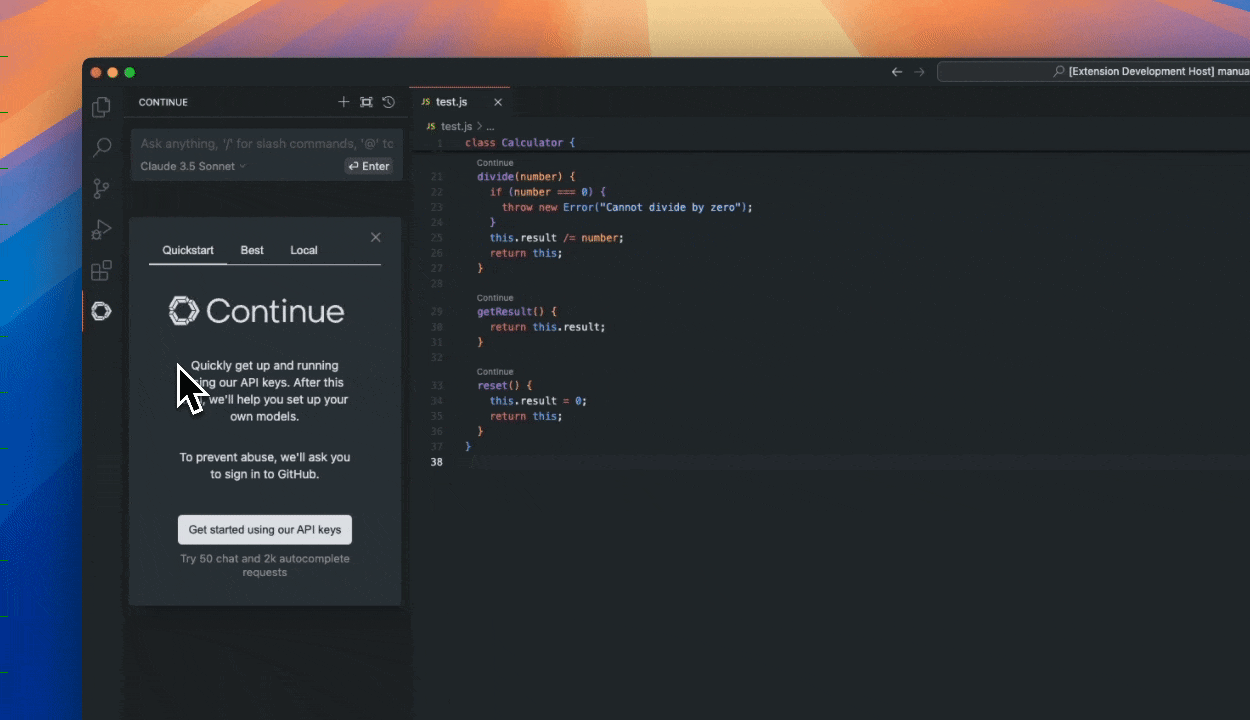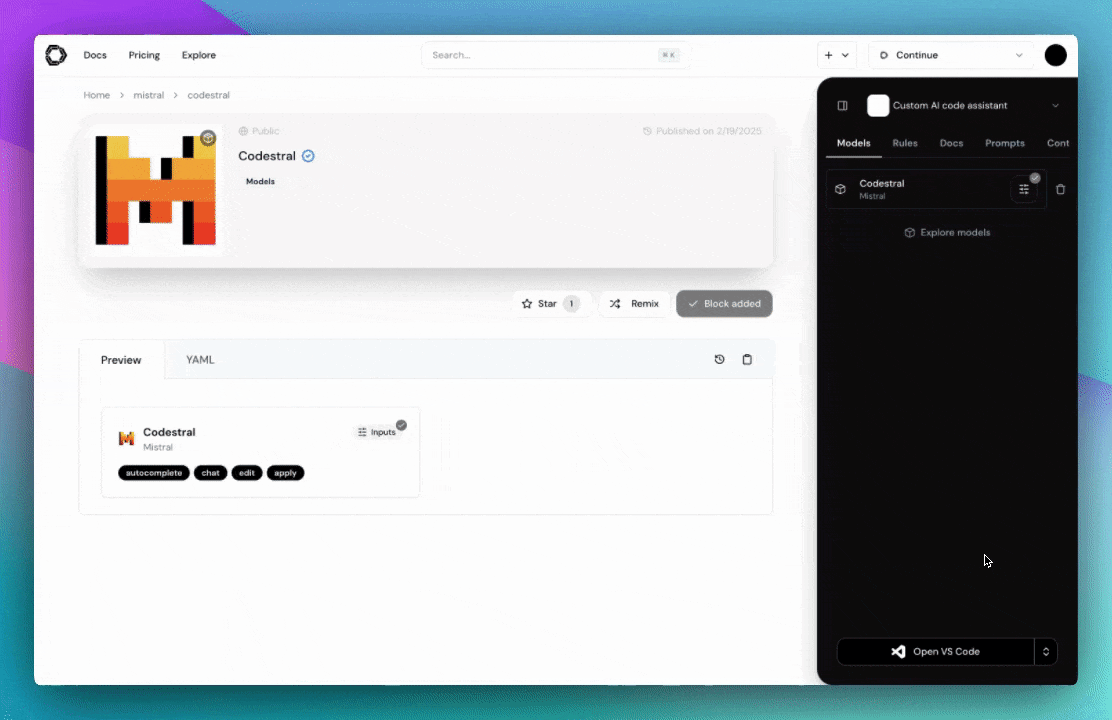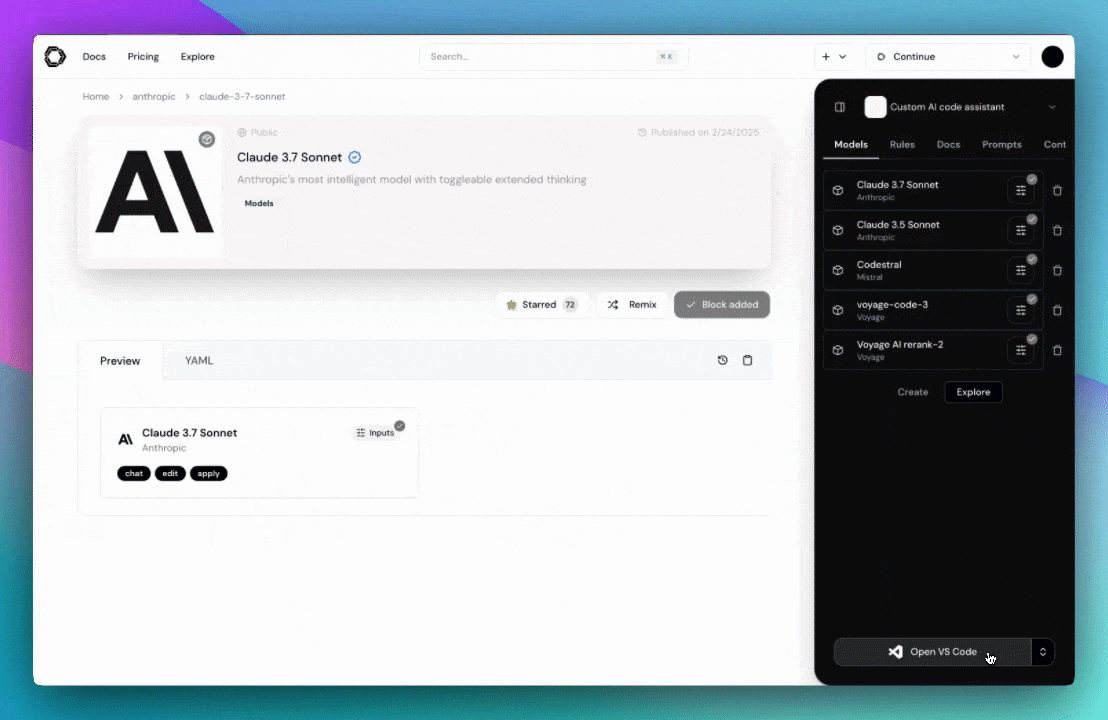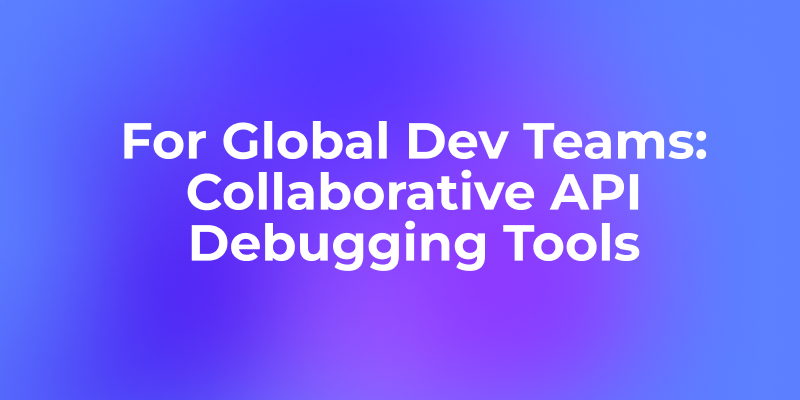
Continue.dev is an AI-powered Integrated Development Environment (IDE) designed to enhance coding efficiency and streamline development workflows. It integrates seamlessly with existing code editors, providing AI-assisted code completion, debugging, and intelligent refactoring. This guide will walk you through how to use Continue.dev effectively, covering installation, setup, key features, and best practices.

Installation and Setup
1. Installing Continue.dev
To get started, follow these steps to install Continue.dev:
- Download the Plugin: Visit the official Continue.dev website and download the plugin for your preferred IDE (VS Code, JetBrains, or any supported editor).
- Install the Extension: For VS Code: Go to the Extensions Marketplace, search for “Continue.dev,” and click Install.
- The Continue logo will appear on the left sidebar. For a better experience, move Continue to the right sidebar.
- Sign in to the hub to get started with your first assistant.

JetBrains
- Open your JetBrains IDE and open Settings using
Ctrl+Alt+S - Open the Plugin Marketplace, search for “Continue.dev,” and install it.
- Click
Install, which will cause the Continue logo to show up on the right toolbar - Sign in to the hub to get started with your first assistant.

Restart the IDE: Once installed, restart your IDE to enable the AI functionality.
Signing in
Click "Get started" to sign in to the hub and start using assistants.

2. Configuring Continue.dev
After installation, configure Continue.dev for optimal performance:
Sign in: Use your Continue.dev account to unlock full features.
Set API Key (if required): Enter your AI model API key in the settings.
Adjust AI Settings: Customize AI suggestions, auto-completion, and debugging preferences.
Key Features
1. AI-Powered Code Completion
Continue.dev predicts and suggests code snippets based on your coding style, significantly speeding up development. It can:
Auto-complete functions, variables, and entire code blocks.
Provide contextual suggestions based on existing project structure.

How to Use Autocomplete
Autocomplete offers inline code suggestions as you type, making coding faster and more efficient.
Enabling Autocomplete: Click the "Continue" button in the status bar at the bottom right of your IDE, or ensure that "Enable Tab Autocomplete" is checked in your IDE settings.
Managing Suggestions
Accept a full suggestion: Press Tab
Reject a full suggestion: Press Esc
Partially accept a suggestion: Use Cmd/Ctrl + → to accept it word-by-word for more precise control.
2. How to Use Chat for LLM Assistance in the IDE
Chat allows you to easily ask for help from an LLM without leaving your IDE. You send it a task with relevant information, and it responds with the text or code most likely to complete the task. If the response isn’t exactly what you need, you can send follow-up messages to refine the result.
Chat is ideal for understanding or iterating on code, or as a replacement for traditional search engine queries.

Basic Actions
Type a Request and Press Enter: Simply send a question or request, and the LLM will respond with an answer or solution.
Highlight Code for Context: Select a code section, then press Cmd/Ctrl + L (VS Code) or Cmd/Ctrl + J (JetBrains) to send it to the LLM. You can then ask for an explanation or request a refactor.
Reference Context with @ Symbol: To include additional context from the codebase, documentation, IDE, or other tools, type @ to select and add it to your query.
Advanced Actions
Apply Generated Code to Your File: When the LLM suggests code changes, click the "Apply" button to update the code in your editor.
Start a Fresh Session: For a new task, press Cmd/Ctrl + L (VS Code) or Cmd/Ctrl + J (JetBrains) to begin a new session, ensuring that only relevant context is included for the new task.
Switch Between Models: If multiple models are available, you can switch between them using the dropdown or by pressing Cmd/Ctrl + '.
3. Edit
How to Use Edit for Code Modification
Edit is a convenient way to make quick and targeted changes to specific code and files without leaving your current workspace. You can highlight code, describe the changes, and see the diffs inline, allowing you to accept or reject them easily.
Edit is best for smaller, specific tasks such as:
Writing comments
Generating unit tests
Refactoring functions or methods

Steps to Use Edit
Highlight Code and Activate Edit Mode: Select the code block you want to modify, then press Cmd/Ctrl + I to activate Edit mode. If no code is highlighted, you can still enter Edit mode by pressing Cmd/Ctrl + I.
Describe Code Changes: Provide a brief and concise description of the changes you want the model to make to your highlighted code. For more complex changes, use the Chat feature instead.
Accept or Reject Changes: Inline diffs will appear within your highlighted text.
Accept changes using Cmd/Ctrl + Opt + Y
Reject changes using Cmd/Ctrl + Opt + N
Accept or reject all changes at once using Cmd/Ctrl + Shift + Enter (accept) or Cmd/Ctrl + Shift + Delete/Backspace (reject).
To request a new suggestion, press Cmd/Ctrl + I again.
Additional Features
VS Code: In VS Code, Edit is available in the extension sidebar with an interface similar to Chat. You can also use the Mode Selector below the Chat input to switch to Edit mode.

JetBrains: In JetBrains, Edit is implemented as an inline popup for single-file edits (multi-file edits are not supported).
Adding Files to Edit
Along with adding highlighted code, you can also manually add files to edit using the Add file combobox or by clicking the dropdown and selecting Add all open files to add all files that are currently open in the editor.
Add file combobox

Add all open files dropdown

Single File Edit: If one file/range is present in Code to Edit on submission, Continue will prompt the Edit model and then automatically stream the diff into the editor.

Multi-File Edit: If multiple files/ranges are present in Code to Edit on submission, Continue will prompt the Edit model to output codeblocks per-file, which the user can then choose to apply and accept/reject independently.
Generated Content

Diffs

4.Agent
How to Use Chat with Agent
Agent is integrated within the same interface as Chat, enabling seamless communication and task management. You can provide natural language instructions to the Agent, and it will handle the necessary steps to complete your request, just like Chat.

Steps to Use Chat with Agent
Natural Language Instructions: Simply type your request in natural language, such as:
“Set the @typescript-eslint/naming-convention rule to 'off' for all eslint configurations in this project.”

Agent will automatically choose the appropriate tools and actions to fulfill the task.
Providing Context: You can also provide context in the same way as with Chat by using methods like @ context providers or adding highlighted code from the editor.
Advantages of Using Agent
Automation: Agent processes your request and decides how to accomplish the task without requiring manual intervention.
Efficiency: You don’t need to figure out which tools to use for your task—Agent will handle that automatically.
Give Agent permission
By default, Agent will ask permission when it wants to use a tool. Click Continue to allow Agent mode to proceed with the tool call or Cancel to reject it.

View Tool Responses
Any data returned from a tool call is automatically fed back into the model as a context item. Most errors are also caught and returned, so that Agent mode can decide how to proceed.

Enhance Your AI IDE with Apidog MCP Integration
Take your Continue.dev experience to the next level with the Apidog MCP Server. This integration enables your AI-powered IDE to directly access and interact with API specifications from Apidog projects. With this setup, Continue.dev can generate code, search API specs, and create structured models seamlessly.

Best Practices
Enable Context Awareness: Configure the AI to analyze entire project files rather than just the active editor window for better suggestions.
Use AI Wisely: AI-generated code should always be reviewed for correctness and security concerns.
Integrate with Version Control: Use Git or another version control system to track AI-generated changes before committing them.
Customize AI Preferences: Adjust the AI’s verbosity, completion style, and debugging level based on your project’s needs.
Leverage AI for Learning: Utilize the AI's explanations and suggestions to improve coding skills and best practices.
Conclusion
Continue.dev AI IDE is a game-changer for developers looking to streamline their workflows with AI assistance. Whether you need faster code completion, efficient debugging, or intelligent refactoring, Continue.dev provides the tools to enhance productivity. By following this guide, you can effectively integrate AI into your development process and take advantage of its powerful features.



